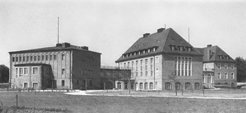Architecture & Environs
The historic research campus in Dahlem, Berlin

The historic research campus in Dahlem, Berlin
In 1912, the first two Kaiser Wilhelm Institutes for Chemistry and Physical Chemistry opened in Dahlem, effectively in the middle of the countryside, where the state had made land available for development. Further Institutes for Biology and Biochemistry followed soon after. Built in the classic Historicist style, the Institutes soon attracted talented and eminent researchers. The Fritz Haber Institute of the Max Planck Society continues the tradition of research in Dahlem to this day. In the 1920s and 1930s, many more Institutes were built, including the Kaiser Wilhelm Institute for Cell Physiology, the building which today houses the Archives of the Max Planck Society.
The architect of all these buildings was Carl Sattler. Having been recruited by the KWG in 1925, he was also tasked with designing Harnack House, including all interior furnishings.

The House added a service center to the growing campus, offering guest rooms, a lecture theater, two restaurants and spaces for meetings, relaxation, and sports. Sattler already had experience of hotel construction from the development of Schloss Elmau, an expansive elite hotel in the Bavarian Alps. He based his designs for Harnack House on the style of an English country house and followed the building ideas of the Deutscher Werkbund – an association of artists and architects focused on design and craftsmanship, of which Sattler was a member. When it opened, the House exuded both style and comfort with its wood paneling, arches and stucco artwork – entirely in keeping with the bourgeois tastes of the scientists it was built to accommodate.
The House escaped damage during the Second World War. However, the surrounding Kaiser Wilhelm Institutes were gradually relocated during that period. In 1948, the newly founded Freie Universität Berlin moved into the vacant buildings. Harnack House was confiscated by Allied forces in 1945. Between then and 1994, it served as an officers’ mess for the US Army, which occupied the south-west sector of Berlin while the city was divided. Due to the numerous alterations made, the building lost its original character, with the addition of two almost detached sections. Wintergarten Hall and what is today called the Meitner Room were among the new additions.
Sattler also planned the park-like garden for Harnack House; his intention was for Dahlem to develop into an elegant residential area with spacious villas and plentiful green and open spaces. Dahlem continues to benefit from this urban development strategy to this day – and the historic science buildings are still in use on the campus.
Visitors can download the DahlemTour Berlin audio guide app to explore these historic sites around Harnack House and discover fascinating details.

